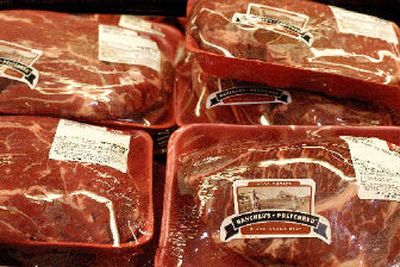Diet trends aggravate U.S. meat glut

SPRINGFIELD, Mo. — Too much of a good thing isn’t good for anyone. That goes for protein, too. After years of people stuffing themselves with chicken, pork and beef while they were following low-carb diets like Atkins, the meat industry is looking at a glut as the diet trend turns toward a more balanced approach.
Benchmark wholesale prices for beef and pork are down more than 8 percent from a year ago and 20 percent for chicken, according to the Livestock Marketing Information Center.
“There is just an overabundance of protein on the market,” the center’s Jim Robb said.
Retail prices for meats are forecast to be flat to 1 percent lower this year compared to a 2 percent to 3 percent increase for all foods, according to the U.S. Department of Agriculture.
Agricultural economists said the oversupply and subsequent dip in prices is part of the normal business cycle. Good profits in 2004 and 2005 tempted farmers and agribusiness companies to raise production faster than the growth in demand.
But changing diets have helped pressure the market, as have export problems for beef and chicken.
Consumers are increasingly shunning high-protein diets like Atkins and South Beach, which have been lauded for inducing rapid weight loss but criticized for raising the intake of fats and cholesterol.
“The popularity of high-protein, low-carb diets gave an extra kick to demand for meats,” said Ronald Plain, professor of agricultural economics at the University of Missouri in Columbia.
“Now we’re in a situation in 2006 where we see an increase in meat production and that (diet) popularity is going away, so the Atkins diet turned out to be like other diets, a passing fad,” Plain said.
DeWayne Gray, a rancher who has 1,450 head of cattle southwest of Springfield, said he has been expecting prices to come down as the normal business cycle holds sway.
“We reached the apex of the cattle cycle around the first of the year,” Gray said.
Big food processors are feeling the effect of what the industry calls an “oversupply of protein.”
The nation’s largest meat processor, Springdale, Ark.-based Tyson Foods Inc., blamed a second quarter loss in part on the protein glut. No. 2 processor Pilgrim’s Pride Corp., based in Pittsburg, Texas, also posted a loss for similar reasons; and Smithfield Foods Inc., the world’s largest pork processor based in Smithfield, Va., said it expects its fiscal fourth-quarter earnings to fall short due to plummeting hog prices.
Overseas health scares are also dampening exports, putting more meat on the home market.
U.S. chicken exports are down as consumers in many foreign markets shun poultry in general over Asian avian bird flu, even though the World Health Organization says properly cooked chicken is no health threat. The H5N1 virus, lethal to bird flocks and blamed for at least 113 human deaths, has spread across Asia to Europe and Africa but has not been detected in the Americas.
Despite diet fads, the long-term trend is for U.S. consumers to eat more meat and spend less for it as producers and processors become more efficient.
The U.S. Department of Agriculture projects a steady rise in annual per capita consumption of red meats and poultry.